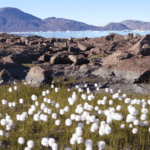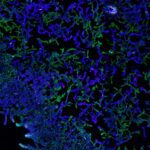In this series, we’re sharing practices of community-engaged research (CER): researchers and community partners working together to advance community goals and science.
Different ways the public participates in scientific research
This spring, a four-legged creature the length of a zucchini darted out from under a parked car in the neighbourhood. Its body divided laterally, the top half—from head to tail—was exactly what I envisioned as “chestnut brown” in colour. The bottom half, white.
I hurriedly took a photo on my phone.
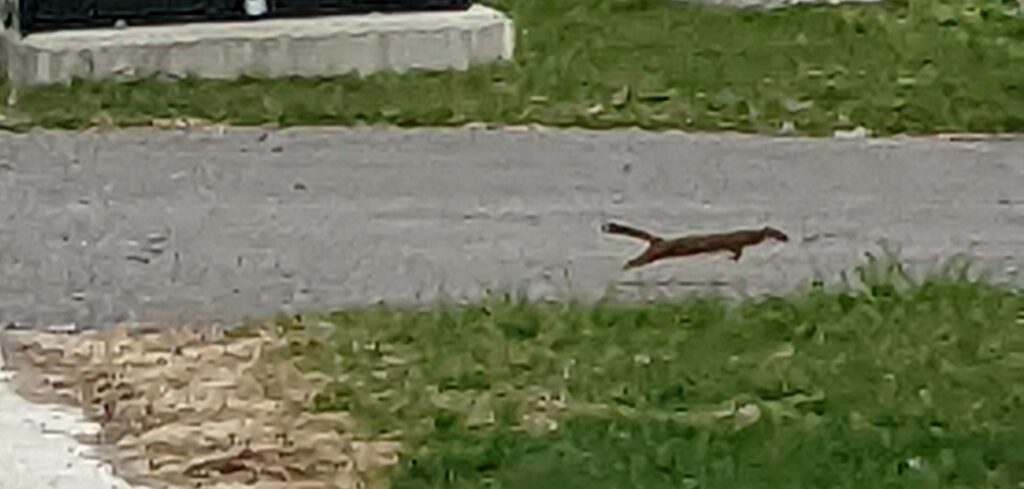 Blurry but usable photo of species to be identified.
Blurry but usable photo of species to be identified.
Then I thought: I’ll look through the Beatrix Potter’s World of Peter Rabbit series I’ve now read to the toddler too many times. I’ll make a species identification from there.
My next thought: Wait, there’s an app for this.
There are many apps. Citizen science* apps help anyone with a smartphone identify living things they’ve seen or heard. When the observation is entered into the app, a data point is created. With observations continually entered by the public, these apps are generating massive datasets which span massive temporal and geographical scales.
Public participation is one of several methods used in community-engaged research (CER). There are different degrees of public participation; members of the public may hire a researcher to complete a project or co-create a project from design to data analysis. There are also different benefits of public participation for both researcher and participant.
Hands-on involvement by the public can help bridge the scientific and societal relevance of a project and build trust in science. This type of involvement is also an opportunity for capacity building and empowering individuals or organizations to achieve their goals.
Read on for examples that highlight the mutual benefits of public participation in scientific research.
Virtual volunteers help catalogue Arctic flora
In December 2019, the Canadian Museum of Nature’s herbarium team, led by curator Jennifer Doubt, launched a new project: Expedition Arctic Botany. The goal, invite the public to help transcribe the text appearing on more than 21, 000 digitized Arctic plant specimens made available on Zooniverse, an online citizen science platform.
Volunteers worldwide first looked at the handwritten labels appearing in digitized images, some of which dated back to the 1800s. Then they submitted the collector’s name and the collection’s number, date, and location. These data points were chosen to set volunteers up for success, Doubt explained; the information is easy to find and can be transcribed in a consistent way.
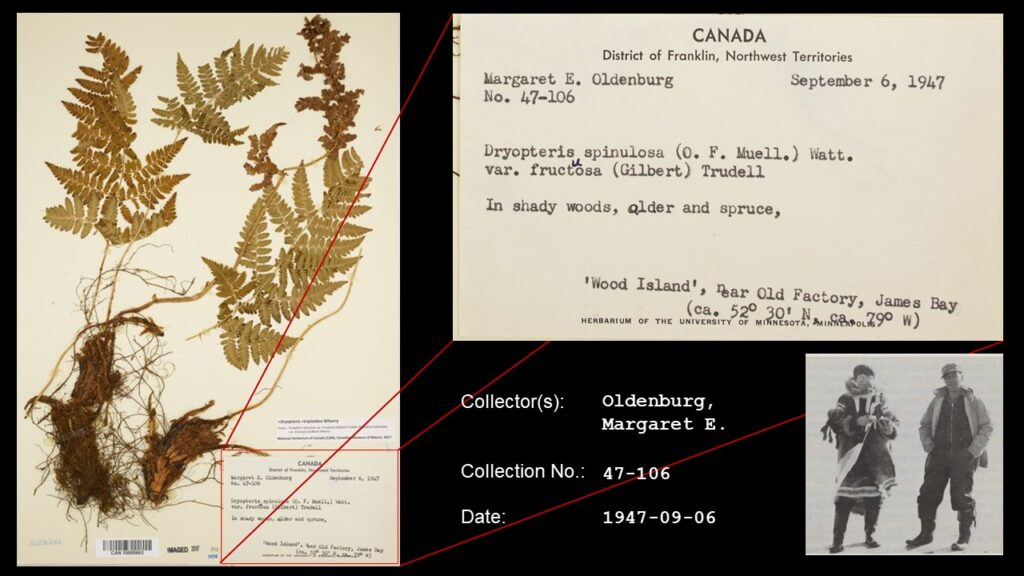 Labels and digitized image of specimen collected by Margaret E. Oldenburg, librarian and botanical specimen collector.
Labels and digitized image of specimen collected by Margaret E. Oldenburg, librarian and botanical specimen collector.
Doubt described the project’s goal as “liberation of data from the cabinets of the museum so anyone, anywhere, can access it anytime.” Thanks to over 2000 volunteers who contributed their time and efforts, what would be a staggering task for a small museum team was completed in less than a year. “The pandemic started pretty soon after [launch] and suddenly people were at home,” said Doubt. “The transcriptions spiked right up.”
Not only did the project add to the museum’s ever-growing dataset—freely available for all to download and use—it fostered a sense of community. Volunteers conversed on discussion boards about the shorthand of certain collectors and gave them nicknames; socializations similar to what Doubt and her colleagues have in-person in the lab. “It really felt like we were expanding our team,” said Doubt of these parallel interactions.
With the success of this project, made possible with funding from the Sitka Foundation, the museum is planning another Zooniverse project for their paleobiology collection.
Monitoring the health of streams with community-collected bugs
They may be tiny, but benthic invertebrates are a big deal when it comes to freshwater quality—they are established indicators of environmental change.
The STREAM (Sequencing the Rivers for Environmental Assessment and Monitoring) project, led by the Hajibabaei lab at the University of Guelph’s Centre for Biodiversity Genomics (CBG), trains community members on how to collect bulk benthic samples so that the aquatic insects in the sample can be identified using DNA metabarcoding. At no shipping or analysis costs to partnering individuals and organizations, reports on benthic biodiversity are provided by STREAM for use to monitor local waters.
DNA metabarcoding is a new way to assess the health of fresh waters. “The metabarcoding technology developed by our lab can give us an enhanced look at aquatic biodiversity,” explains Tamanna Kohi of the Hajibabaei lab.
But for generations, Indigenous communities in Canada have learned on and from the land, observing changes in freshwater ecosystems. In collaboration with The Firelight Group—an Indigenous-owned consulting group—Indigenous communities that steward the watersheds they live in are connecting with STREAM.
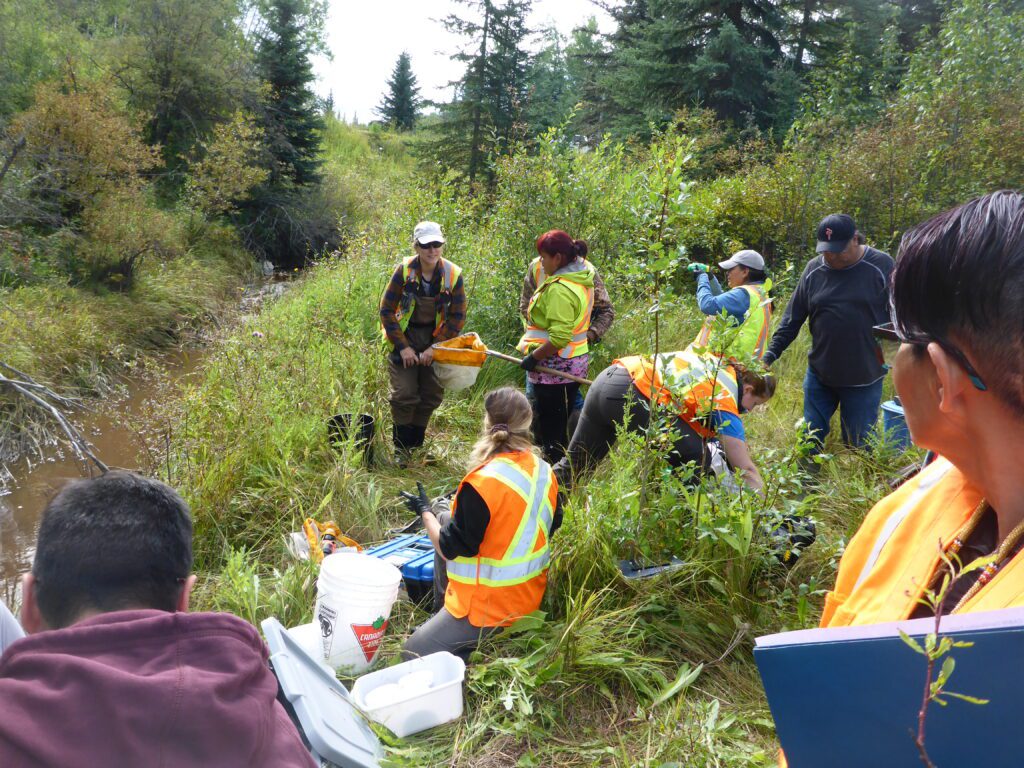 Blueberry River First Nations integrate STREAM training and CABIN sampling into ongoing restoration projects | Used with permission from Living Lakes Canada
Blueberry River First Nations integrate STREAM training and CABIN sampling into ongoing restoration projects | Used with permission from Living Lakes Canada
Training provided by STREAM builds on the existing water stewardship by Indigenous communities, explains Raegan Mallinson of Living Lakes Canada, a charity which co-delivers STREAM along with the CBG, Environment and Climate Change Canada, and World Wildlife Fund-Canada. The specific training is a modified version of CABIN, a standardized method for benthic sampling.
Mallinson emphasizes that while the training can complement community-led monitoring, STREAM supports Indigenous self-determination; adding CABIN to monitoring protocols is a decision made by the Indigenous communities leading those efforts.
The Blueberry River First Nations (BRFN) use CABIN sampling to monitor tributaries in northeast British Columbia. These tributaries are impacted by myriad industrial activities. BRFN has set in action restoration projects which train field technicians with STREAM to strengthen the capacity of the community and use local Indigenous Knowledge as a foundation for the monitoring project.
“There is space and opportunity” for different knowledge systems, says Mallinson of STREAM’s community-based partnership.
NOW AVAILABLE
Community-Engaged Research Collection
Jellyfish outbreaks offer opportunities for collaborative thinking
There are forecasts for the weather. There are forecasts for mortgage rates. Thanks to the collaborative efforts of observant beachgoers and an oceanographer who codes, there are also forecasts for jellyfish.
In 2014, an outbreak of jellyfish prompted residents of Maine to reach out to Dr. Nick Record, Senior Research Scientist at the Bigelow Laboratory for Ocean Sciences, to better understand what causes the outbreaks. Given the public’s curiosity and local knowledge, Record invited the public to email and tweet their sightings to him. Sightings became data that tracked the presence of jellyfish. Record and colleagues used the data to build a forecasting model to predict when an outbreak might happen next.
Seven years on from those first emails and tweets, sightings are now captured with Jellyfish Reporter, a user-friendly online form. But Record still receives emails. “I will email back and forth with people a fair bit if they’re engaged,” he said. “That often leads to me hearing about their own ecological hypotheses.”
 An example jellyfish forecast along the coast of Maine and Atlantic Canada. Warmer colors show a higher likelihood of encountering jellyfish—in this case lion’s mane jellyfish.
An example jellyfish forecast along the coast of Maine and Atlantic Canada. Warmer colors show a higher likelihood of encountering jellyfish—in this case lion’s mane jellyfish.
Some keen contributors are even “taking and analyzing the data themselves, or using the data and their interactions with me to ask and explore their own questions,” Record added.
With an ocean of creatures to forecast, Record founded the Tandy Center for Ocean Forecasting. Like jellyfish forecasting, the Center’s work forecasting whale locations and harmful algal bloom is collaborative.
Oh, you’re wondering what the animal was that I saw? I sent the blurry photo I captured to a biologist friend for identification. After referencing a mammal field guide, the darting creature was deemed most likely to be a long-tailed weasel or ermine.
*Citizen science is a complex term to define. What definition popped into your head when you read those two words? There are ongoing conversations about this term and the different ways to describe a scientific project with public participation.
We thank all the community partners and researchers who shared their knowledge and feedback with us throughout the development of the author resources and blog series.
Blog post written by Natalie Sopinka, communications specialist at Canadian Science Publishing.
Banner image by Sean Booth | Caption: When Pseudomonas bacteria crawl across a surface they coordinate their motion. Here, a video of two differently coloured strains has been collapsed into a single image showing the highly ordered paths cells took, resulting in the appearance of an intricately woven lattice.



